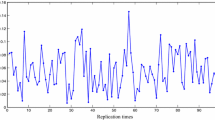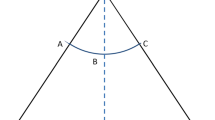Abstract
The intuitionistic fuzzy set, as a generation of Zadeh’ fuzzy set, can express and process uncertainty much better, by introducing hesitation degree. Similarity measures between intuitionistic fuzzy sets (IFSs) are used to indicate the similarity degree between the information carried by IFSs. Although several similarity measures for intuitionistic fuzzy sets have been proposed in previous studies, some of those cannot satisfy the axioms of similarity, or provide counter-intuitive cases. In this paper, we first review several widely used similarity measures and then propose new similarity measures. As the consistency of two IFSs, the proposed similarity measure is defined by the direct operation on the membership function, non-membership function, hesitation function and the upper bound of membership function of two IFS, rather than based on the distance measure or the relationship of membership and non-membership functions. It proves that the proposed similarity measures satisfy the properties of the axiomatic definition for similarity measures. Comparison between the previous similarity measures and the proposed similarity measure indicates that the proposed similarity measure does not provide any counter-intuitive cases. Moreover, it is demonstrated that the proposed similarity measure is capable of discriminating the difference between patterns.
Similar content being viewed by others
References
Zadeh LA (1965) Fuzzy sets. Inf Control 8:338–353
Atanassov KT (1986) Intuitionistic Fuzzy-Sets. Fuzzy Set Syst 20:87–96
Xu Z, Yager RR (2008) Dynamic intuitionistic fuzzy multi-attribute decision making. Int J Approx Reason 48:246–262
Gau WL, Buehrer DJ (1993) Vague Sets. IEEE Trans Syst Man Cybern 23:610–614
Bustince H, Burillo P (1996) Vague sets are intuitionistic fuzzy sets. Fuzzy Set Syst 79:403–405
Xia MM, Xu ZS (2010) Some new similarity measures for intuitionistic fuzzy values and their application in group decision making. J Syst Sci Syst Eng 19:430–452
Ye J (2011) Cosine similarity measures for intuitionistic fuzzy sets and their applications. Math Comput Model 53:91–97
Szmidt E, Kacprzyk J (2000) Distances between intuitionistic fuzzy sets. Fuzzy Set Syst 114:505–518
Wang WQ, Xin XL (2005) Distance measure between intuitionistic fuzzy sets. Pattern Recognit Lett 26:2063–2069
Grzegorzewski P (2004) Distances between intuitionistic fuzzy sets and/or interval-valued fuzzy sets based on the Hausdorff metric. Fuzzy Sets Syst 148:319–328
Chen T-Y (2007) A note on distances between intuitionistic fuzzy sets and/or interval-valued fuzzy sets based on the Hausdorff metric. Fuzzy Sets Syst 158:2523–2525
Hung WL, Yang MS (2004) Similarity measures of intuitionistic fuzzy sets based on Hausdorff distance. Pattern Recognit Lett 25:1603–1611
Li DF, Cheng CT (2002) New similarity measures of intuitionistic fuzzy sets and application to pattern recognitions. Pattern Recognit Lett 23:221–225
Mitchell HB (2003) On the Dengfeng-Chuntian similarity measure and its application to pattern recognition. Pattern Recognit Lett 24:3101–3104
Liang ZZ, Shi PF (2003) Similarity measures on intuitionistic fuzzy sets. Pattern Recognit Lett 24:2687–2693
Li Y, Olson DL, Qin Z (2007) Similarity measures between intuitionistic fuzzy (vague) sets: a comparative analysis. Pattern Recognit Lett 28:278–285
Hwang CM, Yang MS, Hung WL, Lee MG (2012) A similarity measure of intuitionistic fuzzy sets based on the Sugeno integral with its application to pattern recognition. Inf Sci 189:93–109
Xu ZS (2007) Some similarity measures of intuitionistic fuzzy sets and their applications to multiple attribute decision making. Fuzzy Optim Decis Ma 6:109–121
Xu ZS, Chen J (2008) An overview of distance and similarity measures of intuitionistic fuzzy sets. Int J Uncertain Fuzz 16:529–555
Xu ZS, Yager RR (2009) Intuitionistic and interval-valued intuitionistic fuzzy preference relations and their measures of similarity for the evaluation of agreement within a group. Fuzzy Optim Decis Ma 8:123–139
Zeng WY, Guo P (2008) Normalized distance, similarity measure, inclusion measure and entropy of interval-valued fuzzy sets and their relationship. Inf Sci 178:1334–1342
Wei CP,Wang P, Zhang YZ (2011) Entropy, similarity measure of interval-valued intuitionistic fuzzy sets and their applications. Inf Sci 181:4273–4286
Boran FE, Akay D (2014) A biparametric similarity measure on intuitionistic fuzzy sets with applications to pattern recognition. Inf Sci 255:45–57
Zhang H, Yu L (2013) New distance measures between intuitionistic fuzzy sets and interval-valued fuzzy sets. Inf Sci 245:181–196
Li J, Deng G (2012) The relationship between similarity measure and entropy of intuitionistic fuzzy sets. Inf Sci 188:314–321
Li DF (2004) Some measures of dissimilarity in intuitionistic fuzzy structures. J Comput Syst Sci 68:115–122
Papakostas GA (2013) Distance and similarity measures between intuitionistic fuzzy sets: A comparative analysis from a pattern recognition point of view. Pattern Recognit Lett 34:1609–1622
Chen SM (1995) Measures of similarity between vague sets. Fuzzy Sets Syst 74:217–223
Hong DH, Kim C (1999) A note on similarity measures between vague sets and between elements. Inf Sci 115:83–96
Li F., Xu Z (2001) Similarity measures between vague sets. J Software 12:922–927
Li Y, Chi Z, Yan D (2002) Similarity measures between vague sets and vague entropy. J Comput Sci 29:129–132
Vlachos IK, Sergiadis GD (2007) Intuitionistic fuzzy information-application to pattern recognition. Pattern Recognit Lett 28:197–206
Szmidt E, Kacprzyk J (2004) A similarity measure for intuitionistic fuzzy sets and its application in supporting medical diagnostic reasoning. In: ICAISC, pp 388–393
Szmidt E, Kacprzyk J (2001) Intuitionistic fuzzy sets in intelligent data analysis for medical diagnosis. In: ICCS, pp 263–271
Own CM (2009) Switching between type-2 fuzzy sets and intuitionistic fuzzy sets: an application in medical diagnosis. Appl Intell 31 (3):283–291
De SK, Biswas R (2001) A.R. Roy, An application of intuitionistic fuzzy sets in medical diagnosis. Fuzzy Set Syst 117:209–213
Acknowledgments
The authors would like thank the anonymous reviewers for their insightful and constructive comments. This work was supported by the National Natural Science Foundation of China (Nos. 61273275 and 60975026.).
Author information
Authors and Affiliations
Corresponding author
Rights and permissions
About this article
Cite this article
Song, Y., Wang, X., Lei, L. et al. A novel similarity measure on intuitionistic fuzzy sets with its applications. Appl Intell 42, 252–261 (2015). https://doi.org/10.1007/s10489-014-0596-z
Published:
Issue Date:
DOI: https://doi.org/10.1007/s10489-014-0596-z




